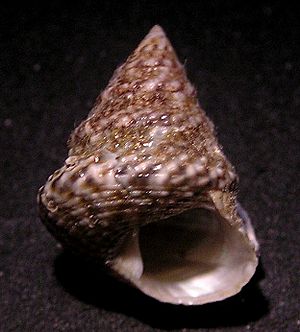Calthalotia arruensis facts for kids
Quick facts for kids Calthalotia arruensis |
|
|---|---|
 |
|
| Apertural view of a shell of Calthalotia arruensis | |
| Scientific classification | |
| Synonyms | |
|
Calthalotia arruensis is a type of sea snail. It belongs to the family called Trochidae. These snails are often found in the ocean.
Contents
What Does Calthalotia arruensis Look Like?
This snail has a strong, solid shell. It is shaped like a cone. The shell is flat at its bottom. It has small bumps, called tubercles, all over it. The shell is usually gray and pink.
Shell Patterns and Texture
The shell has eight rows of small, round bumps. These rows spiral around each whorl (or turn) of the shell. The bumps in the first two rows are bigger. They are separated by small dips. The next three rows also have these dips. The last three rows are closer together. They stick out a little, especially the middle one.
The bottom of the shell has about nine spiral lines. These lines also have small bumps. There are even weaker lines between them. The bumps on the shell are smooth and shiny. But the space between them is finely wrinkled.
Shell Color and Shape
The shell is white. It has pretty grayish-purple patches on top. The bottom of the shell has many purplish-pink spots. The top part of the shell, called the spire, is tall and pointy.
The spire has a curved, cone-like shape. It is slightly bumpy where the sutures (lines where the whorls join) are. This is because of the two top rows of bumps. The shell has about ten flat whorls. They grow bigger in a very even way. The suture lines are small but clear. They are marked by a slight ridge above and two rows of large bumps below.
Opening and Inside the Shell
The opening of the shell, called the aperture, is quite small. It looks square and is slanted. The outer edge of the opening is sharp but strong. The inner edge is supported by a shiny, pearl-like layer. This layer forms a tooth-like shape near the columella. The columella is the central pillar of the shell. It is angled to a sharp edge. It completely closes the belly button-like hole, called the umbilicus. This leaves only a small dip and a groove behind the columella. The snail's lid, called the operculum, is thin, yellow, and normal.
Where Does Calthalotia arruensis Live?
This sea snail lives only in Australia. It is found off the coast of Queensland.

